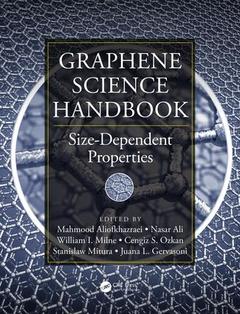Graphene Science Handbook Size-Dependent Properties
Coordonnateurs : Aliofkhazraei Mahmood, Ali Nasar, Milne William I., Ozkan Cengiz S., Mitura Stanislaw, Gervasoni Juana L.

Size Up the Short- and Long-Term Effects of Graphene
The Graphene Science Handbook is a six-volume set that describes graphene?s special structural, electrical, and chemical properties. The book considers how these properties can be used in different applications (including the development of batteries, fuel cells, photovoltaic cells, and supercapacitors based on graphene) and produced on a massive and global scale.
Volume One: Fabrication Methods
Volume Two: Nanostructure and Atomic Arrangement
Volume Three: Electrical and Optical Properties
Volume Four: Mechanical and Chemical Properties
Volume Five: Size-Dependent Properties
Volume Six: Applications and Industrialization
This handbook describes the fabrication methods of graphene; the nanostructure and atomic arrangement of graphene; graphene?s electrical and optical properties; the mechanical and chemical properties of graphene; the size effects in graphene, characterization, and applications based on size-affected properties; and the application and industrialization of graphene.
Volume five is dedicated to size effects in graphene, characterization, and applications based on size-affected properties and covers:
- The use of graphene as a tunnel barrier for both charge and spin transport
- The mechanical behavior of Kevlar?graphene fibers
- Size-controlled graphene and cases of graphene nanostructures with size-dependent properties
- The applications of graphene as adsorbents, supporting and hybridization materials, and catalysts for removal of pollutants in contaminated water and air
- Recent research efforts to synthesize a variety of graphene-based structures
- The properties of indirect coupling between magnetic moments in monolayer graphene nanostructures
- The recent results of the electronic properties of graphene/metal systems
- Interface traps in graphene field-effect devices
- Semi-analytical models for the calculation of the quantum capacitance of both monolayer and bilayer graphene and its nanoribbons
- The various properties of mono- and multilayers of silicene compared with the corresponding properties of graphene
- The most relevant data obtained in the field of the vibrational characterization of graphene and graphene-based materials and more
SIZE EFFECT IN GRAPHENE.CHARACTERIZATION. APPLICATIONS.
Date de parution : 05-2016
21x28 cm
Thèmes de Graphene Science Handbook :
Mots-clés :
GS; Go; A Spin-Polarized Tunnel Barrier; Graphene Layer; Kevlar Reinforced by Graphene; Dirac Point; Adsorption of Graphene in Environmental Remediation; American Chemical Society; Catalysis of Graphene in Environmental Remediation; Pristine Graphene; Graphene Oxide-Derived Porous Materials; Graphene Nanosheets; Hydrogen Storage; Quantum Capacitance; Methane Storage; Graphene Composites; Carbon Capture; RGO; Indirect Coupling; NEXAFS Spectrum; Localized Magnetic Moments; GNRs; Graphene Nanostructures; Electron Hole Puddles; Excitonic Effects; BiLG; Armchair Graphene Nanoribbons; BS; Graphene Epitaxially Grown on Metal Substrates; Armchair Direction; Synchrotron-Based Spectroscopies; Zigzag Direction; Graphene Field-Effect Transistor Chemical Sensors; CCG; Graphene Field-Effect Transistor Biological Sensors; Armchair GNRs; Interface Traps; Monolayer Graphene; Graphene Field-Effect Devices; Magnetic Properties; Band Gap; Nanographene Bilayer; Eld Effect Mobility; RIXS Spectrum; Graphene Sheets; Raman Spectrum; Nanoribbons; Two-Dimensional Silicon; Carbon Systems; FTIR Spectroscopy; Single-Layer Graphene; Grain Boundary Loops; Functionalized Graphene; Electron Spectroscopy; Nanographene Patterns; Focused Ion Beam-Induced Deposition; XPS; Raman Scattering; Thermophysical Properties; Electrophysical Properties; Composite Films; Multi-Walled Carbon Nanotubes; Multilayered Graphene; Graphene Gas Sensor; Single-Molecule Gas Detection; Photocatalytic Applications; Transparent Contact Layers; Diffusion Barriers; Thermal Management Layers; Graphene Oxide; Dye-Sensitized Solar Cells; Graphene RF Transistors; Silicon CMOS-Compatible Processing; Nanoelectronics; Lithium Battery; Graphene Nanocomposite Coatings; Graphene-Based Electrochemical Capacitors



